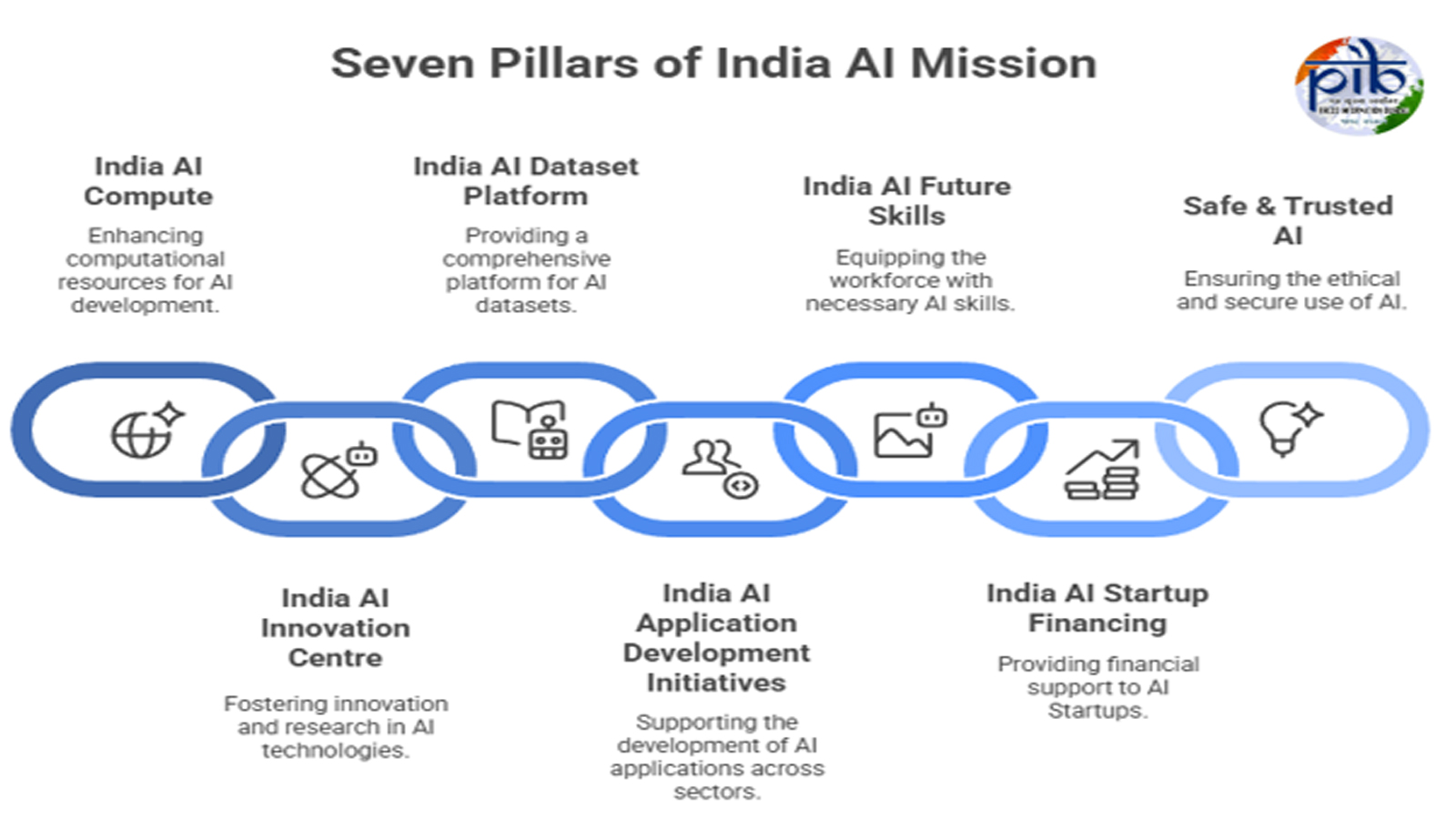India is entering a transformative decade powered by Artificial Intelligence (AI), as the government rolls out a series of ambitious initiatives designed to make the technology open, affordable, and accessible for every citizen. With an investment of over ₹10,300 crore in the IndiaAI Mission and a massive deployment of 38,000 GPUs, the country is building one of the largest and most inclusive AI ecosystems in the world.
The goal is clear: to ensure AI doesn’t just drive growth—it transforms lives. Whether it’s healthcare in rural villages, personalised learning in classrooms, climate forecasting, or strengthening justice delivery, AI is being woven into the fabric of everyday life.
Launched in March 2024, the IndiaAI Mission is guided by the vision of “Making AI in India and Making AI Work for India.” Backed by a ₹10,371.92 crore outlay, the mission has already surpassed its initial GPU target, offering high-end computing at subsidised rates of just ₹65 per hour.
Under the leadership of the Ministry of Electronics and Information Technology (MeitY), the mission is structured around seven pillars, including affordable compute access, application development, AIKosh datasets, indigenous foundation models, future skills, startup financing, and responsible AI governance.
More than 30 India-specific AI applications have been approved so far in sectors such as healthcare, agriculture, and cybersecurity. AIKosh, the national dataset platform, hosts over 3,000 datasets and 243 AI models—enabling developers to build powerful solutions faster.
India’s technology sector continues to surge, with revenues projected to cross USD 280 billion this year. Over six million people are already employed in the tech and AI ecosystem, and 87% of enterprises are actively using AI solutions.
The country hosts 1,800+ Global Capability Centres, including more than 500 dedicated to AI. Nearly 89% of startups launched in 2024 integrated AI into their products or services. On the NASSCOM AI Adoption Index, India scores 2.45 out of 4, reflecting rapid and widespread enterprise-level integration.
Globally, India ranks among the top four countries in AI skills, capabilities, and policies, according to the Stanford Institute for Human-Centered Artificial Intelligence AI Index. It is also the second-largest contributor to AI projects on GitHub.
To drive research-led innovation, the government has established Centres of Excellence in healthcare, agriculture, sustainable cities, and education. These hubs bring together industry, academia, and government to co-create scalable AI solutions.
A parallel initiative – the AI Competency Framework—is equipping government officials with AI skills, ensuring policy and governance remain future-ready.
Meanwhile, the IndiaAI Startups Global Acceleration Programme, launched in partnership with Station F and HEC Paris, is giving Indian startups a global platform.
AI’s most powerful impact is its ability to make technology more inclusive. Bhashini, India’s multilingual AI platform, breaks language barriers and helps citizens access digital services in 20 Indian languages. With over one million downloads and 350+ AI models, it’s bringing digital governance to millions.
In June 2025, Digital India Bhashini Division and Centre for Railway Information Systems signed an MoU to deploy voice-based translation tools across railway platforms.
Another landmark step was the launch of BharatGen AI—India’s first government-funded, multimodal large language model supporting 22 Indian languages. Built using domestic datasets, BharatGen is designed to reflect India’s cultural diversity while powering innovation across startups, research labs, and government services.
AI’s success depends on talent. Through the IndiaAI FutureSkills programme, more than 13,500 scholars—including undergraduates, postgraduates, and PhD researchers—are being supported.
AI and Data Labs are being established in Tier 2 and Tier 3 cities in collaboration with National Institute of Electronics & Information Technology (NIELIT). By July 2025, 27 labs were operational, with more planned.
Transforming Daily Life: AI in Action
* Healthcare: AI is assisting doctors with early disease detection, telemedicine, and diagnostics. India’s collaboration with global bodies such as HealthAI is ensuring safe and ethical innovation.
* Agriculture: Tools like Kisan e-Mitra and AI-based pest surveillance help farmers boost yields and reduce risks.
* Education: Under National Council of Educational Research and Training’s DIKSHA platform and the YUVAi initiative, students are learning to build AI solutions for real-world problems.
* Governance & Justice: AI is accelerating translation of judgments, automating filings, and improving citizen access to justice through the Supreme Court of India’s e-Courts Project.
* Weather & Climate: AI models are enhancing India’s ability to forecast cyclones, floods, and droughts, helping authorities respond faster.
While concerns around job displacement persist, India’s AI strategy focuses on workforce transformation rather than replacement. According to NASSCOM, India’s AI talent pool is expected to double to 1.25 million professionals by 2027. Programmes like FutureSkills PRIME are helping lakhs of professionals upskill in AI, data analytics, and emerging technologies.
The NITI Aayog report AI for Inclusive Societal Development lays out a vision for empowering 490 million informal workers through technology. The upcoming Digital ShramSetu Mission aims to deploy AI, IoT, blockchain, and immersive tools to bridge systemic gaps in healthcare, skilling, and financial inclusion.
The mission will roll out in four phases between 2025 and 2035, starting with pilots in high-readiness sectors before scaling nationwide.
India will showcase its AI capabilities at the India AI Impact Summit 2026 in February, featuring 300+ exhibitors from over 30 countries. The event will spotlight responsible innovation, indigenous foundational models, and global collaboration.
AI is expected to contribute an estimated $1.7 trillion to India’s economy by 2035. But beyond numbers, the government’s strategy is rooted in inclusion—ensuring no citizen is left behind in the digital revolution.
From powering smart classrooms to strengthening disaster response, India’s AI journey is not just about technology. It’s about empowering people, transforming livelihoods, and shaping a Viksit Bharat by 2047.










